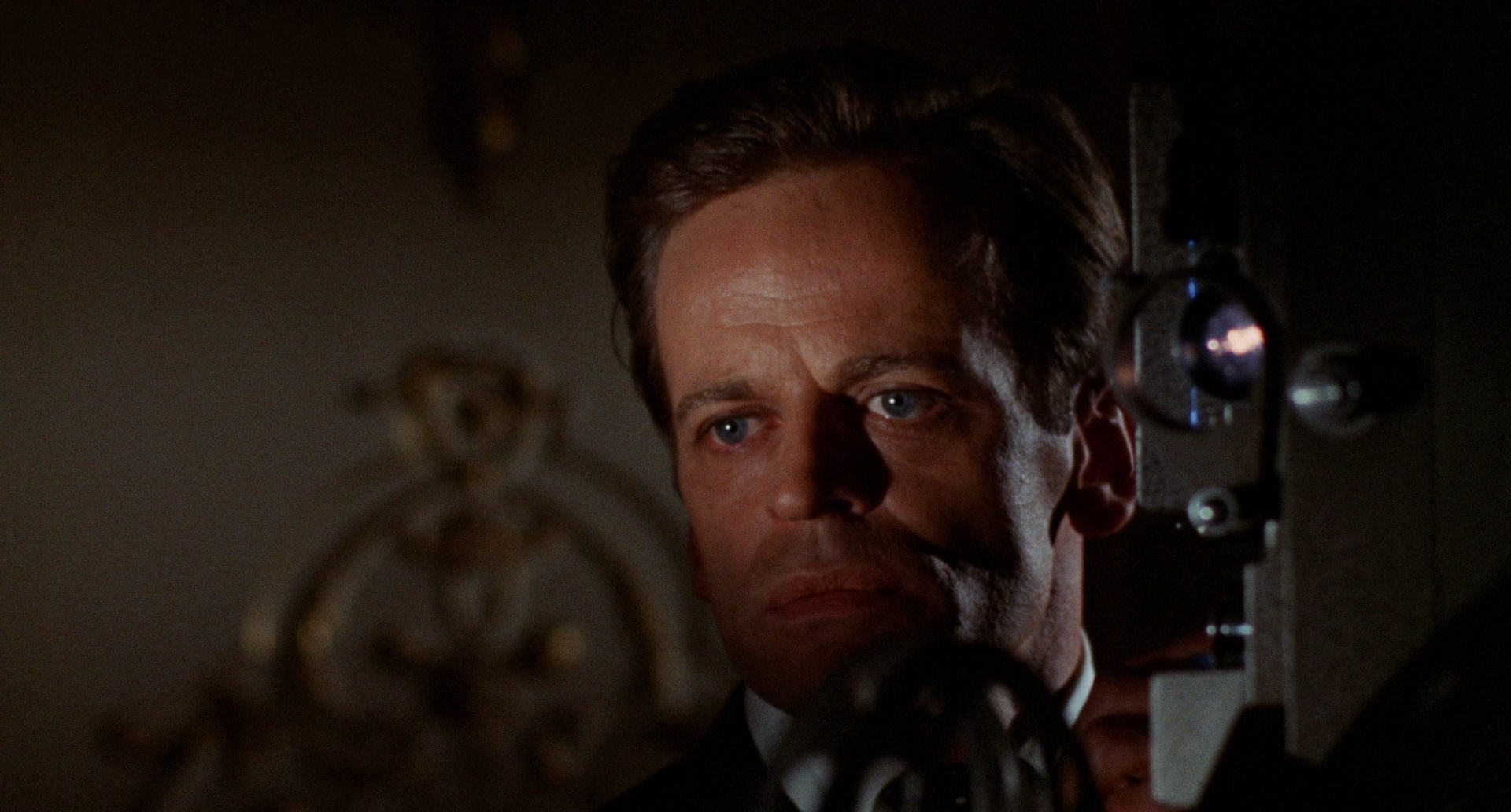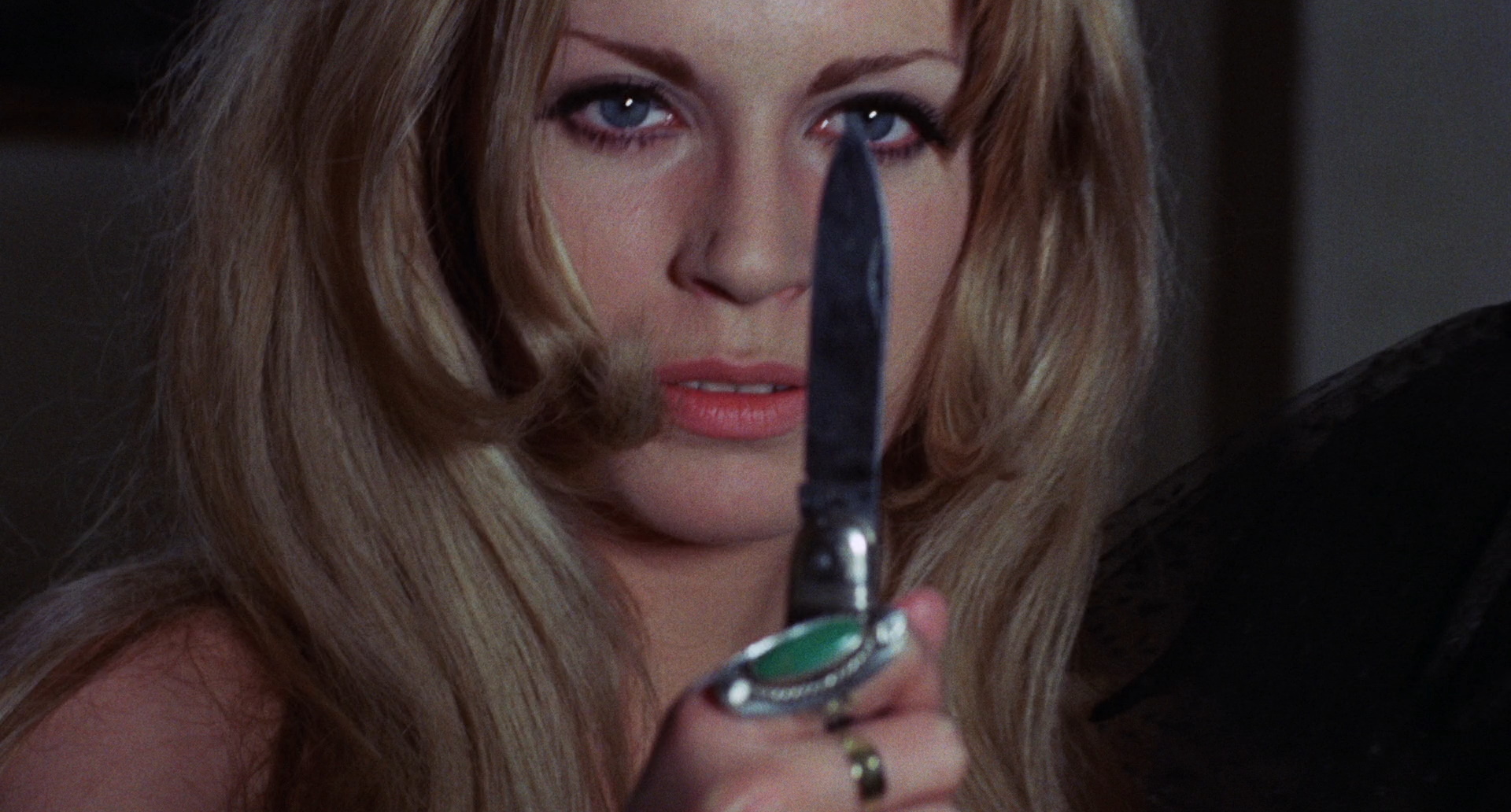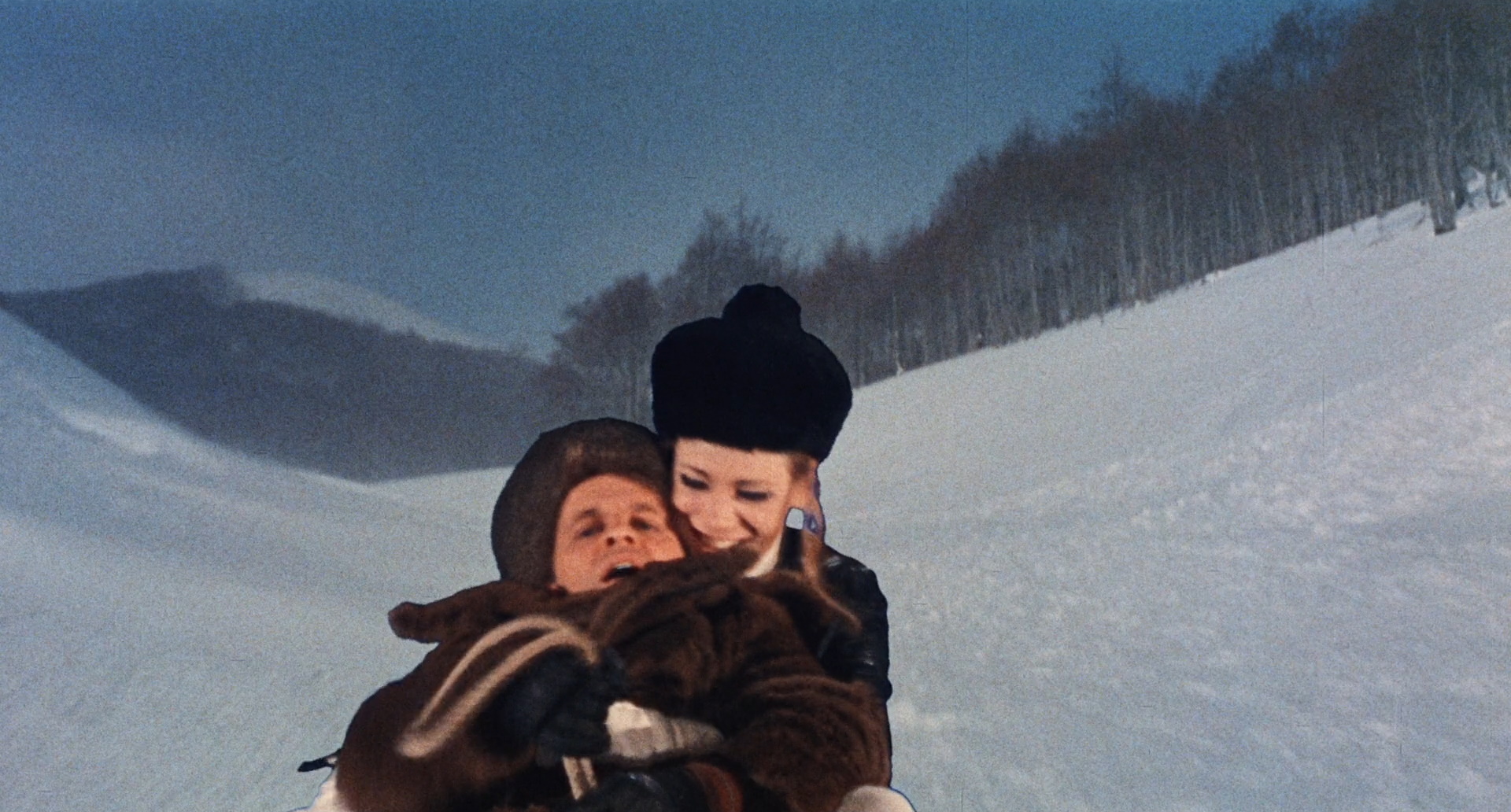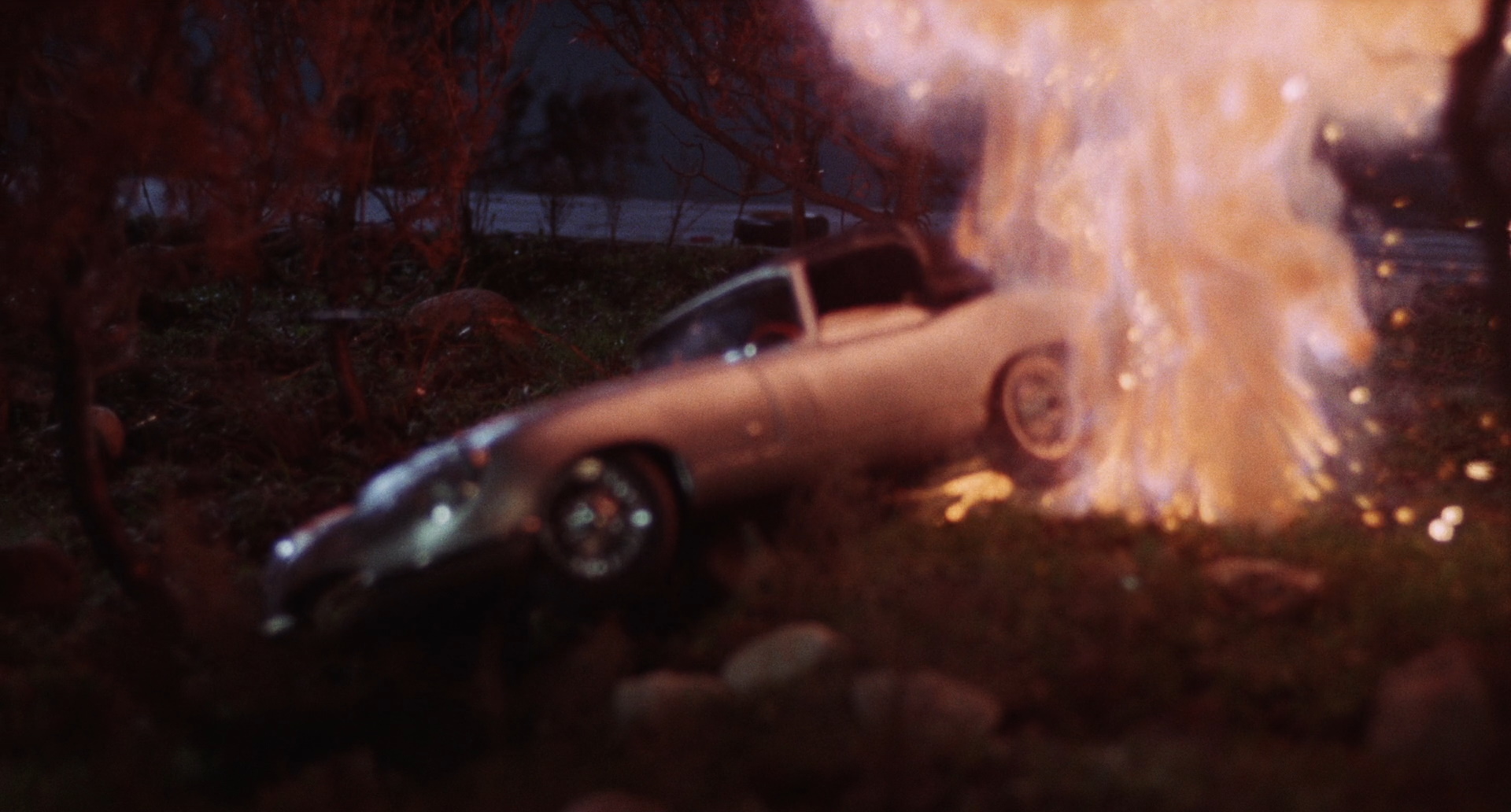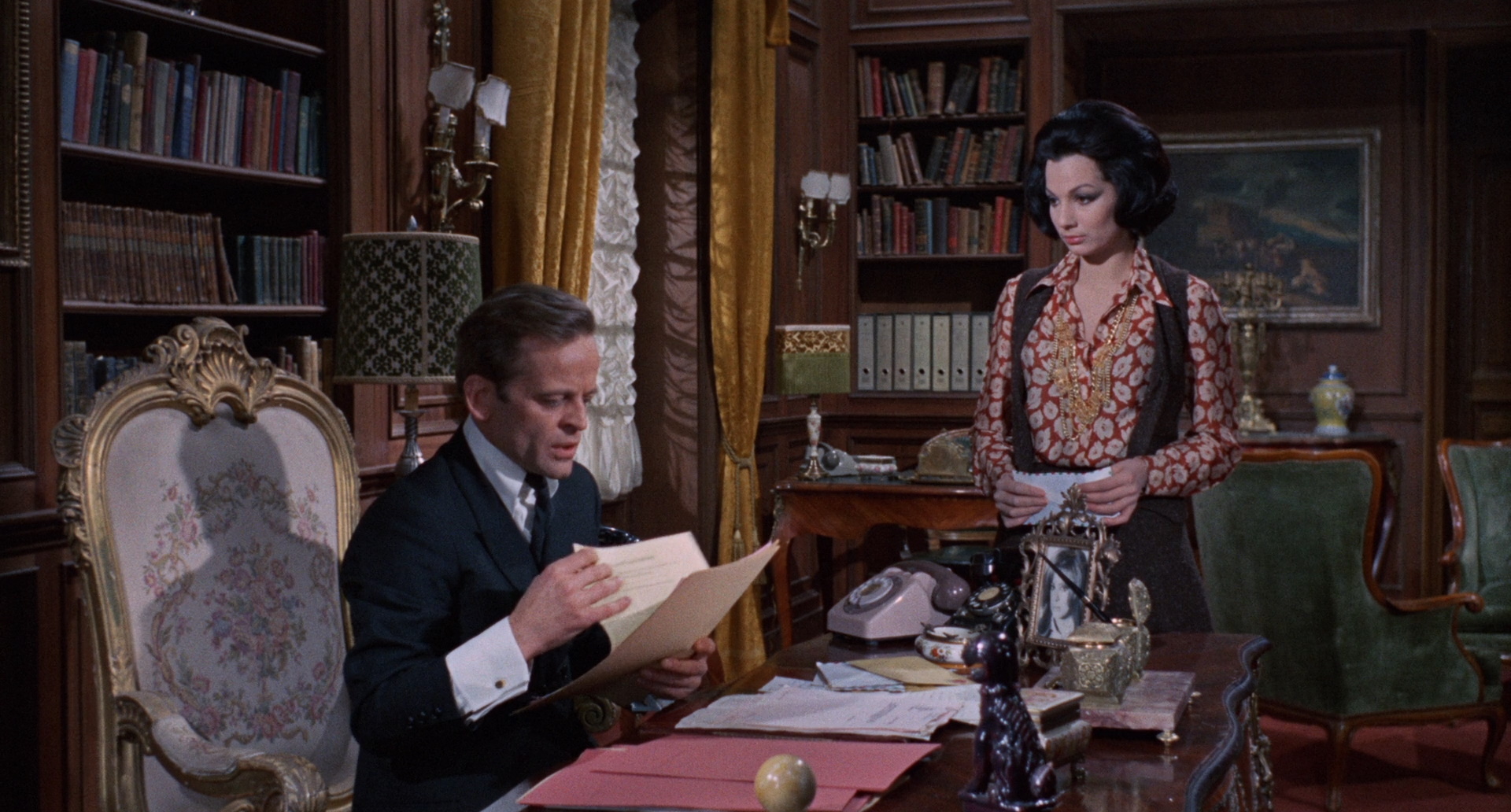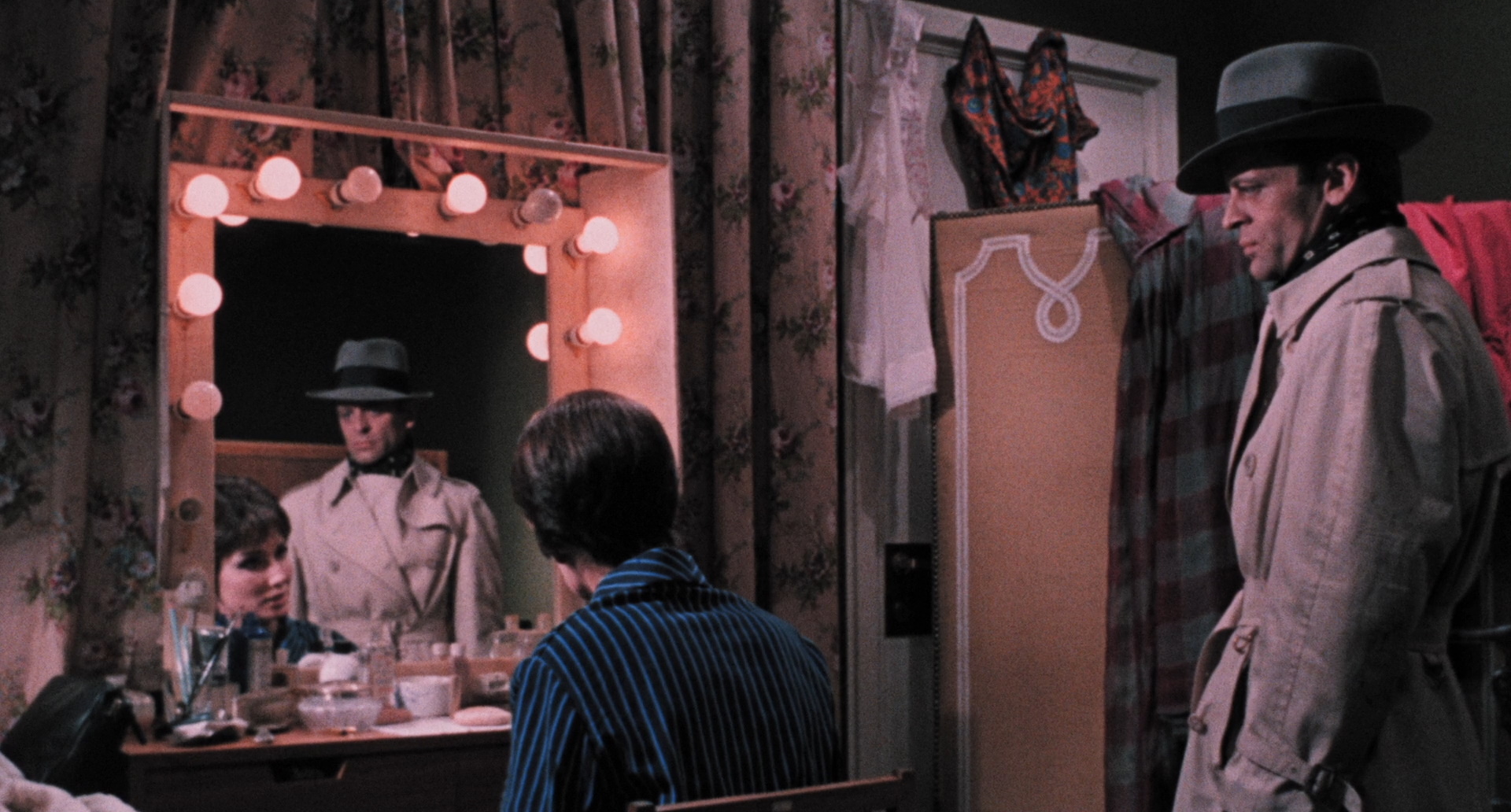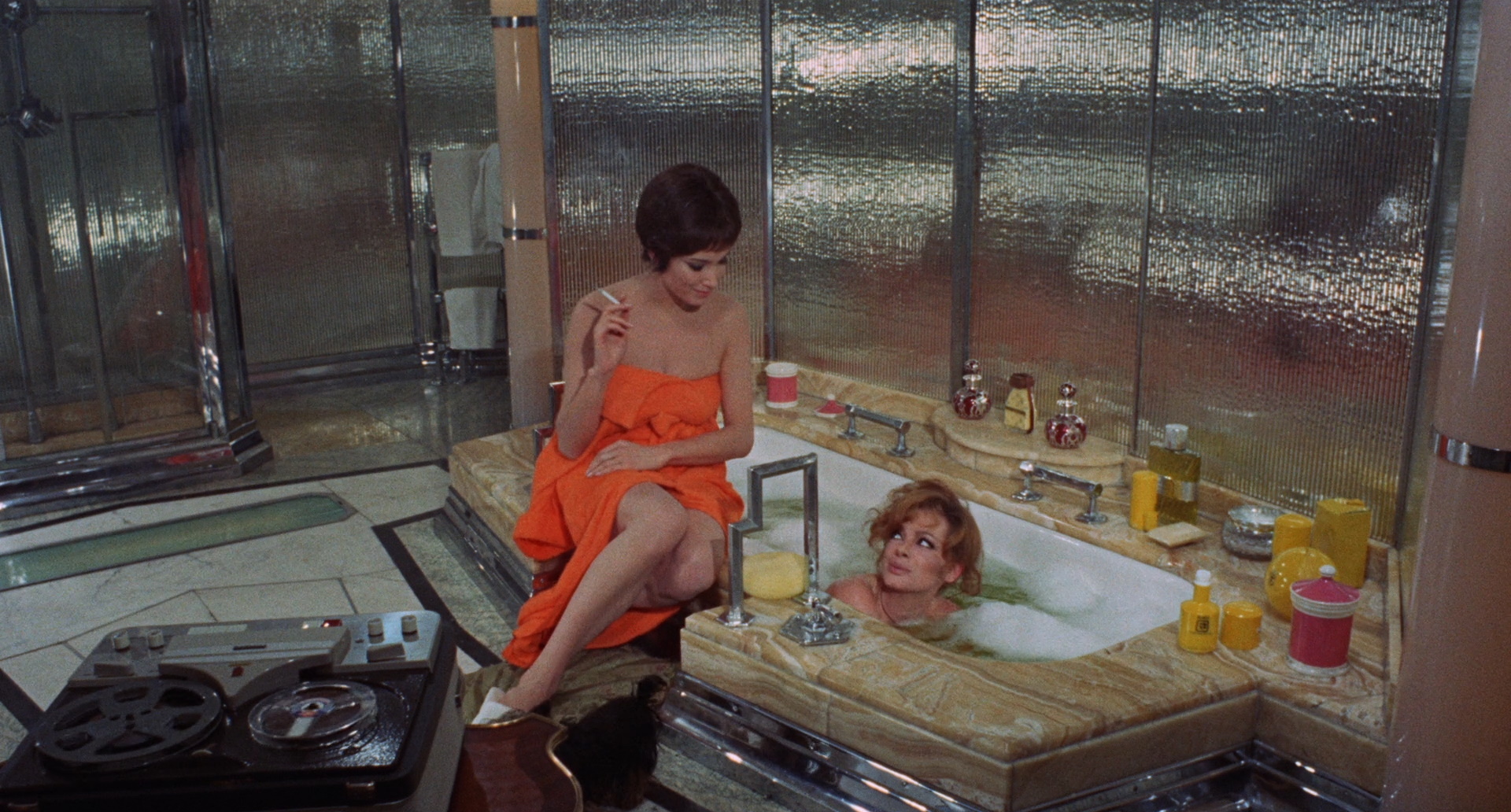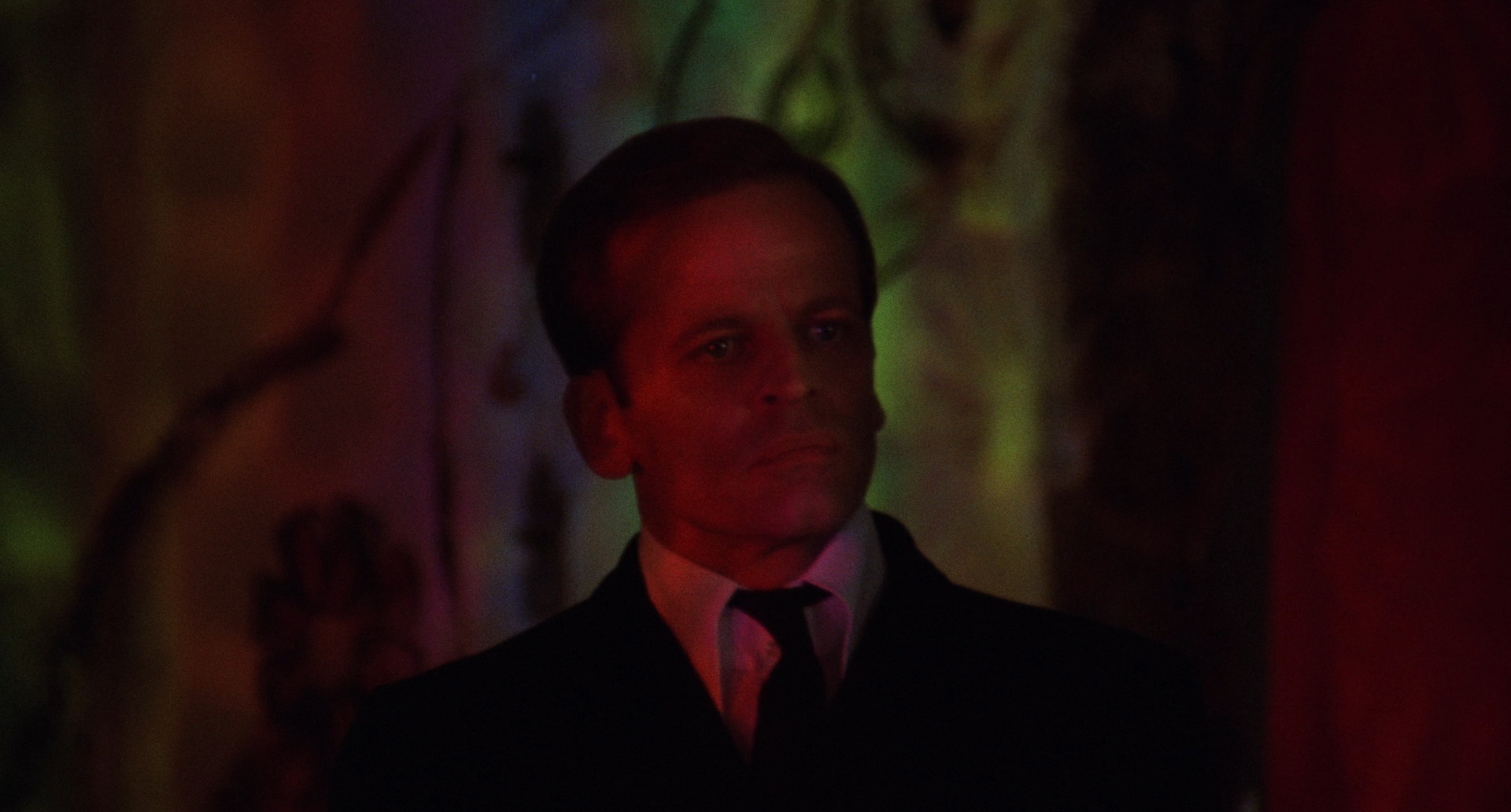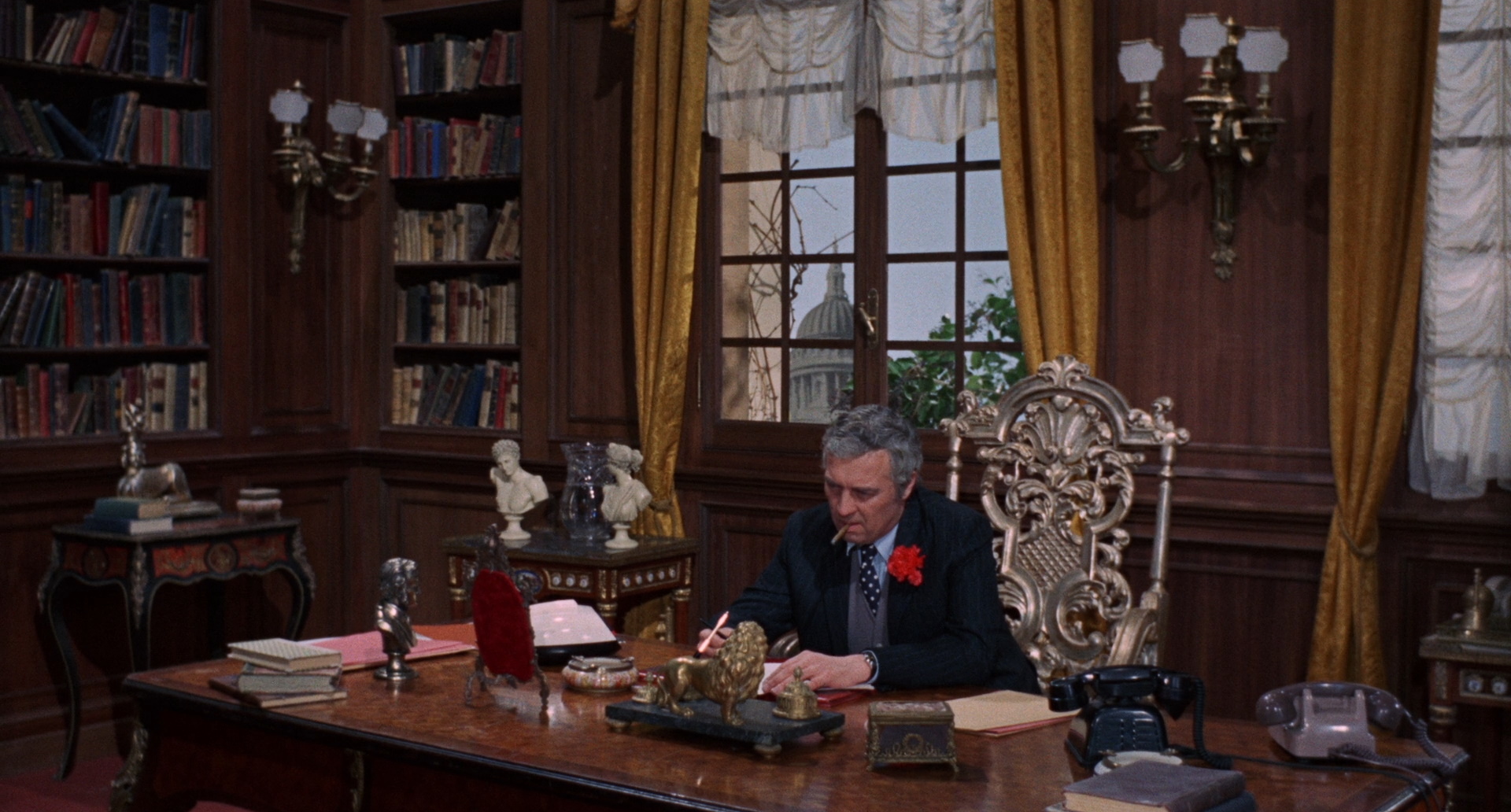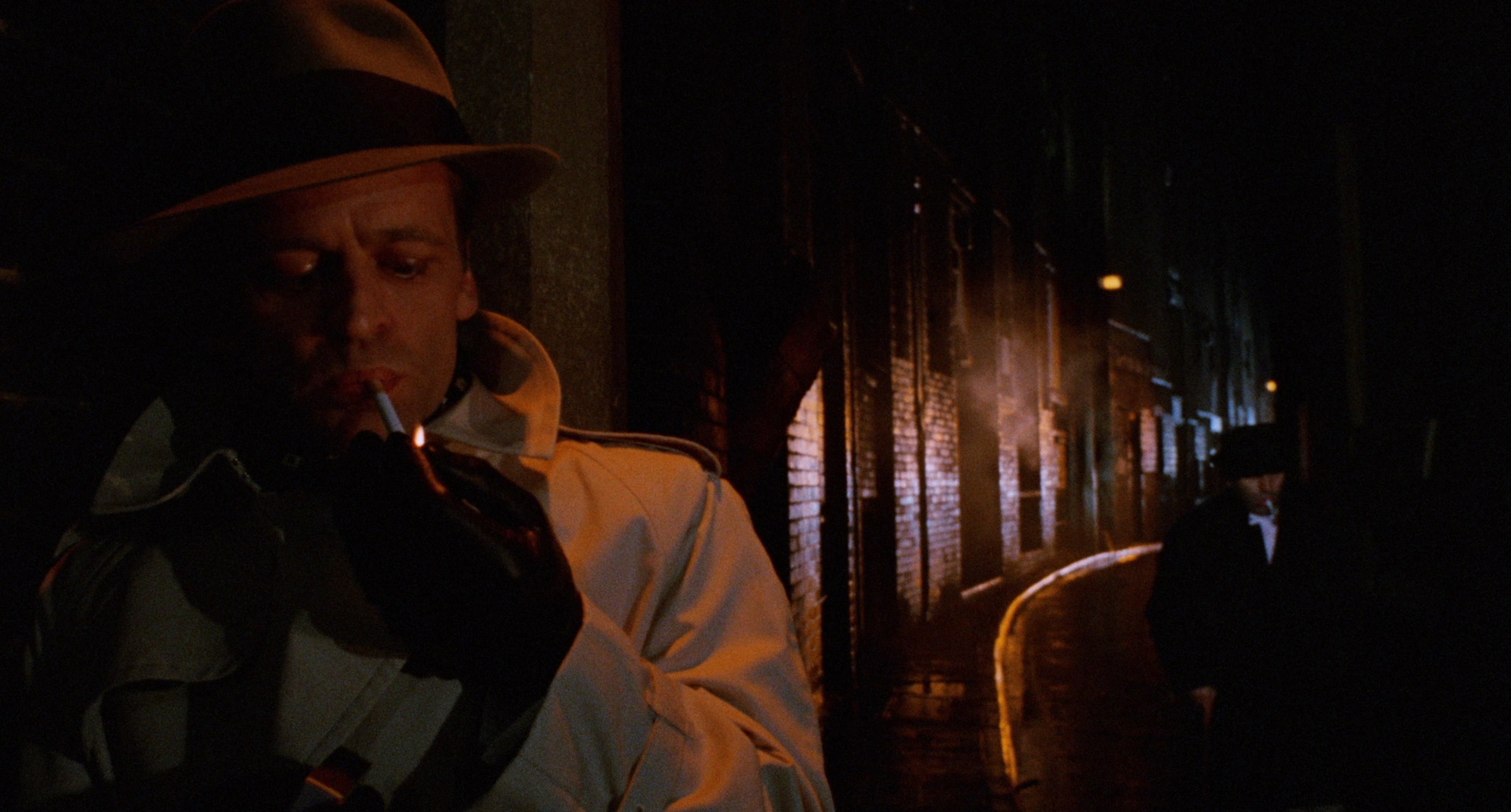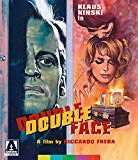| Reviews & Columns |
|
Reviews DVD TV on DVD Blu-ray 4K UHD International DVDs In Theaters Reviews by Studio Video Games Features Collector Series DVDs Easter Egg Database Interviews DVD Talk Radio Feature Articles Columns Anime Talk DVD Savant Horror DVDs The M.O.D. Squad Art House HD Talk Silent DVD
|
DVD Talk Forum |
|
|
| Resources |
|
DVD Price Search Customer Service #'s RCE Info Links |
|
Columns
|
|
|
Double Face
Arrow Video // Unrated // June 25, 2019
List Price: $39.95 [Buy now and save at Amazon]
The honeymoon is over. Helen (Margaret Lee) doesn't find it worth the bother to mask her sapphic passions for Liz (Annabella Incontrera), much as her husband John (Klaus Kinski) can't seem to keep his hands off his secretary. Though neither of them have the least bit interest in fidelity, Helen doesn't bear John any ill will. Helen has, as point of fact, just told John that she's named him the sole heir to her family company and untold millions of dollars. Perhaps it's no coincidence that, shortly after this revelation, Helen's car is found engulfed in flames – its driver burnt beyond recognition.
It's deemed an accident, though the press and police alike find it unsettling that John would spend the weeks following his wife's untimely death jetsetting across Europe. His icy demeanor and the explanation that follows do little to convince others that John is, in his own way, grieving. He's not quite the opportunist many assume him to be, however. Even when John discovers nubile eighteen year old Christine (Christiane Krüger) – fully nude, of course – squatting in his palatial home, he doesn't want a damned thing to do with her. She leads John down a psychedelic rabbit hole, culminating in the screening of a lesbian stag film. One of its stars never shows her face, but she wears Helen's distinctive ring and has a scar on her neck also precisely matching that of John's late wife. The film was shot just a few days ago, long after the accident. Could Helen somehow have emerged alive from that flaming wreck? Is John, as the authorities increasingly suspect, to blame for that catastrophe? Is some sort of reckoning at hand?
Double Face is invariably described as a combination of krimi and giallo – one genre in decline, the other ascendent. In many ways, it's the worst of both worlds. Double Face has no interest in any of its central characters being particularly likeable or sympathetic. We're unable to place ourselves in the shoes of doggedly determined police investigators. We aren't wounded by the swift loss of Helen. More troublesome still, Double Face's ambiguity about John's role in all this confuses ambiguity for intrigue. Though there's the dramatic irony of the audience being well-aware that this was no accident, the film wants us to be uncertain whether or not John engineered the fiery explosion. Kinski's performance is icy and taciturn. John says little, perhaps to avoid revealing anything more to viewers than necessary. He rarely shows any overt signs of grief. But with no character to cheer on, no one to root against, and too little of interest occurring along the way, Double Face isn't terribly compelling.
Those who perk up at the mention of giallo, expecting a leather gloved maniac and a series of visceral murders, will surely be disappointed. There's effectively nothing along those lines, and what few special effects are to be had are...well:
The intrigue largely revolves around some unseen puppet master's machinations. John is being toyed with, like a cat batting around a mouse. For instance, he awakes from a drug-induced stupor to find his late wife's furs replaced by the black veil of The Countess from the porn reel. For nearly the entirety of Double Face's runtime, though, the twists and turns aren't anything remarkable. The questions it poses – who died in the fiery wreck? who's to blame? to what end is John being manipulated? – don't leave me in desperate need of answers. Kinski playing against type in a rather subdued performance is more compelling in theory than in practice. At least the proceedings are livened up by a considerable amount of nudity, most memorably the trippy Happening in London with bikers tearing off the clothes of dancing, nubile flower children. And, in true giallo fashion, Double Face does culminate in a gloriously over-the-top finalé, though it doesn't salvage the largely uninvolving hour and a half preceding it.
Double Face is a competently crafted film. The cast acquits itself well, comprised largely of faces more than familiar to those who follow Italian and German genre cinema. The production design and cinematography are often striking, and it's little wonder that Nora Orlandi and her score are a focal point of this disc's extras. Aside from those laughably wretched effects from very early in the movie, Double Face doesn't really embarrass itself. Though hardly a disaster, neither is it an involving, masterfully paced thriller. Difficult to recommend sight-unseen.
Video
There are so many moments throughout Double Face where I found myself awestruck:
From its very first shot, the clarity and detail on display at effectively every turn eclipsed my expectations. Though L'Immagine Ritrovata fielded the 2K restoration, Double Face was graded in London, so the severe tints so often associated with Ritrovata's work are not an issue in the slightest. Particularly impressive are the rich oranges of the car wreck as well as the rainbow hues of the psychedelic happening. Shadow detail remains robust throughout; inky though they are, dark city streets and the suit worn by a grieving John are never devoured by a sea of impenetrable black. The presentation is every bit as filmic as I'd hoped to see, and I'm sure it goes without saying that there are no missteps or hiccups in the compression either.
The blue screen skiing sequence has some presumably baked-in wear, and there is some deliberate damage on the film-within-a-film. Otherwise, there's really only one brief moment that doesn't look exceptional. Around 72 minutes in, when John confronts Liz in the Globe Theatre, the colors noticeably shift and the image softens. It's limited to a single shot, although it's a somewhat lengthy one:
Not that any of that is genuinely a concern; I'm just being unnecessarily thorough. This breathtaking presentation of Double Face is lightly letterboxed to preserve its original aspect ratio of 1.85:1, and the film with its extras come close to maxing out the capacity of this dual-layered disc.
Audio
Double Face features 24-bit, uncompressed monaural audio in both English and Italian. The film branches to different opening and closing credits, depending on which language is selected. Per usual, I opted to watch Double Face in its entirety in Italian, and I went back afterwards and sampled a few sequences in English. As all of the dialogue you're hearing was recorded in post-production regardless, there's no canonically correct soundtrack, and it's all a matter of personal preference. If you're curious how the two compare, I've recorded the following from John and Christine's initial conversation in his bedroom:
Everything I'm hearing sounds marvelous. Although I could detect some light background noise at times, it's far too mild to ever pose a distraction. The monaural audio is impressively clean and clear throughout, not tarnished by so much as the faintest flicker of distortion. There are no overt flaws to speak of at all, honestly. I'm floored by both the reproduction of the dialogue and the presentation of Nora Orlandi's terrific score. As close to perfection as I could hope for, as if anyone would expect less from Arrow.
Two English subtitle streams are provided – one subtitled for the deaf and hard of hearing for the English track, and the other a proper translation of the Italian audio. Also included is an audio commentary, although as film historian Tim Lucas notes, that might not be quite the term for it.
Extras
Graham Humphreys' artwork looks phenomenal, though if that's not to your tastes, the reversible cover features vintage artwork under the film's Italian title, A doppia faccia. The liner notes include Neil Mitchell's engaging and well-researched essay "A Bastard Child: Double Face", which explores Freda's intermingling of genres, meta-commentary on sexual and violent imagery via the film-within-a-film, and both its difficult production and convoluted release. Double Face is coded for Region A.
The Final Word
Arrow Video has delivered as spectacular a release of Double Face as could be hoped for, with well over three hours of extras and a world-class presentation. Longtime admirers of the film will doubtless be thrilled, and for them, it comes very highly recommended. Those who've yet to be introduced to Double Face, this thriller-in-name-only is too uninvolving and glacially paced to recommend shelling out thirtysomeodd dollars as a purchase sight-unseen.
It's deemed an accident, though the press and police alike find it unsettling that John would spend the weeks following his wife's untimely death jetsetting across Europe. His icy demeanor and the explanation that follows do little to convince others that John is, in his own way, grieving. He's not quite the opportunist many assume him to be, however. Even when John discovers nubile eighteen year old Christine (Christiane Krüger) – fully nude, of course – squatting in his palatial home, he doesn't want a damned thing to do with her. She leads John down a psychedelic rabbit hole, culminating in the screening of a lesbian stag film. One of its stars never shows her face, but she wears Helen's distinctive ring and has a scar on her neck also precisely matching that of John's late wife. The film was shot just a few days ago, long after the accident. Could Helen somehow have emerged alive from that flaming wreck? Is John, as the authorities increasingly suspect, to blame for that catastrophe? Is some sort of reckoning at hand?
Double Face is invariably described as a combination of krimi and giallo – one genre in decline, the other ascendent. In many ways, it's the worst of both worlds. Double Face has no interest in any of its central characters being particularly likeable or sympathetic. We're unable to place ourselves in the shoes of doggedly determined police investigators. We aren't wounded by the swift loss of Helen. More troublesome still, Double Face's ambiguity about John's role in all this confuses ambiguity for intrigue. Though there's the dramatic irony of the audience being well-aware that this was no accident, the film wants us to be uncertain whether or not John engineered the fiery explosion. Kinski's performance is icy and taciturn. John says little, perhaps to avoid revealing anything more to viewers than necessary. He rarely shows any overt signs of grief. But with no character to cheer on, no one to root against, and too little of interest occurring along the way, Double Face isn't terribly compelling.
Those who perk up at the mention of giallo, expecting a leather gloved maniac and a series of visceral murders, will surely be disappointed. There's effectively nothing along those lines, and what few special effects are to be had are...well:
The intrigue largely revolves around some unseen puppet master's machinations. John is being toyed with, like a cat batting around a mouse. For instance, he awakes from a drug-induced stupor to find his late wife's furs replaced by the black veil of The Countess from the porn reel. For nearly the entirety of Double Face's runtime, though, the twists and turns aren't anything remarkable. The questions it poses – who died in the fiery wreck? who's to blame? to what end is John being manipulated? – don't leave me in desperate need of answers. Kinski playing against type in a rather subdued performance is more compelling in theory than in practice. At least the proceedings are livened up by a considerable amount of nudity, most memorably the trippy Happening in London with bikers tearing off the clothes of dancing, nubile flower children. And, in true giallo fashion, Double Face does culminate in a gloriously over-the-top finalé, though it doesn't salvage the largely uninvolving hour and a half preceding it.
Double Face is a competently crafted film. The cast acquits itself well, comprised largely of faces more than familiar to those who follow Italian and German genre cinema. The production design and cinematography are often striking, and it's little wonder that Nora Orlandi and her score are a focal point of this disc's extras. Aside from those laughably wretched effects from very early in the movie, Double Face doesn't really embarrass itself. Though hardly a disaster, neither is it an involving, masterfully paced thriller. Difficult to recommend sight-unseen.
Video
There are so many moments throughout Double Face where I found myself awestruck:
From its very first shot, the clarity and detail on display at effectively every turn eclipsed my expectations. Though L'Immagine Ritrovata fielded the 2K restoration, Double Face was graded in London, so the severe tints so often associated with Ritrovata's work are not an issue in the slightest. Particularly impressive are the rich oranges of the car wreck as well as the rainbow hues of the psychedelic happening. Shadow detail remains robust throughout; inky though they are, dark city streets and the suit worn by a grieving John are never devoured by a sea of impenetrable black. The presentation is every bit as filmic as I'd hoped to see, and I'm sure it goes without saying that there are no missteps or hiccups in the compression either.
The blue screen skiing sequence has some presumably baked-in wear, and there is some deliberate damage on the film-within-a-film. Otherwise, there's really only one brief moment that doesn't look exceptional. Around 72 minutes in, when John confronts Liz in the Globe Theatre, the colors noticeably shift and the image softens. It's limited to a single shot, although it's a somewhat lengthy one:
Not that any of that is genuinely a concern; I'm just being unnecessarily thorough. This breathtaking presentation of Double Face is lightly letterboxed to preserve its original aspect ratio of 1.85:1, and the film with its extras come close to maxing out the capacity of this dual-layered disc.
Audio
Double Face features 24-bit, uncompressed monaural audio in both English and Italian. The film branches to different opening and closing credits, depending on which language is selected. Per usual, I opted to watch Double Face in its entirety in Italian, and I went back afterwards and sampled a few sequences in English. As all of the dialogue you're hearing was recorded in post-production regardless, there's no canonically correct soundtrack, and it's all a matter of personal preference. If you're curious how the two compare, I've recorded the following from John and Christine's initial conversation in his bedroom:
| English | Italian |
Everything I'm hearing sounds marvelous. Although I could detect some light background noise at times, it's far too mild to ever pose a distraction. The monaural audio is impressively clean and clear throughout, not tarnished by so much as the faintest flicker of distortion. There are no overt flaws to speak of at all, honestly. I'm floored by both the reproduction of the dialogue and the presentation of Nora Orlandi's terrific score. As close to perfection as I could hope for, as if anyone would expect less from Arrow.
Two English subtitle streams are provided – one subtitled for the deaf and hard of hearing for the English track, and the other a proper translation of the Italian audio. Also included is an audio commentary, although as film historian Tim Lucas notes, that might not be quite the term for it.
Extras
- Audio Commentary: As this is a film released in so many different versions, and it wasn't clear at the time of recording which one Arrow would be bringing to Blu-ray, a screen-specific commentary for Double Face wasn't in the cards. Tim Lucas describes what he has delivered instead as an audio essay, but whatever you choose to call it, this is the only of the disc's featured extras to be oriented primarily around Double Face.
Lucas addresses its marriage of the krimi with the giallo, its German producers misleadingly selling Double Face in their homeland as an Edgar Wallace adaptation, its respectable budget not being reflected on-screen, considering the possibility that the screenplay that Klaus Kinski was handed had transformed greatly by the time filming had wrapped, and director Riccardo Freda cleverly manipulating Kinski into rejoining the production after leaving midway. Lucas leverages his wealth of knowledge of European genre cinema, such as drawing parallels with co-writer Lucio Fulci's Perversion Story and A Lizard in a Woman's Skin, and he has much to say about the talent on both sides of the camera. Other highlights include an analysis of Double Face's social strata and giallo's compulsion to drag down the privileged, likening a recurring, confrontational song to Bardot's stare in Contempt, noting that Liz appears to be starring in the Globe Theatre's long-running production of There's a Girl in My Soup, and nudity serving as a plot device rather than just mere titillation. This is a rewarding listen, as Lucas' commentaries always are.
- The Many Faces of Nora Orlandi (43 min.; HD): Tim Lucas notes in his audio essay that the only of Double Face's key contributors at the peak of their brilliance is composer Nora Orlandi. Not only is Orlandi and her work a frequent topic of discussion throughout Lucas' commentary, but she is also the focal point of the disc's extras overall.
In much the same vein as his phenomenal discussion and analysis of Stelvio Cipriani in Arrow's The Iguana with the Tongue of Fire, musician and storico della musica giallo Lovely Jon delves in-depth into Orlandi's life and career. We learn what an immediately compelling figure she was even before composing for cinema – the sister of a successful pop singer, the triple threat of being a talented singer, violinist, and pianist at an astonishingly early age, and the driving force of her ubiquitous 4+4 choir. Excerpted here are many of the films to which the choir contributed, singles featuring Orlandi's voice and music, and portions of many of her own seventeen credited film scores. Among her work are the scores for The Beckett Affair, Sheriff with the Gold, The Sweet Body of Deborah, Ten Thousand Dollars for a Massacre, Death Does Not Count the Dollars, and The Strange Vice of Mrs. Wardh. Lovely Jon also delves into Orlandi's working relationships with her key collaborators, her work after film, and her relatively recent rediscovery by soundtrack fanatics. His intimate knowledge of Italian genre cinema and music in general is startlingly thorough and endlessly engaging, so much so that I'd readily point to "The Many Faces of Nora Orlandi" as the most exceptional of Double Face's extras.
And, indeed, Double Face is discussed at length. Lovely Jon explains how Orlandi's more baroque, gothic score diverges from what would typically be expected from a giallo, as well as its vocalizations and unique instrumental arrangements, his extensive detective work into which musicians performed on the soundtrack, and how much of Double Face's power is found in the moments between the notes. Though there aren't any grand pieces, Lovely Jon does explore several of his favorite musical moments, analyzing the different versions of the main theme (such as one's unexpectedly dialed-down electric guitar) and a memorable sequence in which the music is diagetic.
- 7 Notes for a Murderer (32 min.; HD): "I have seven notes and one head. Maybe I copied myself, but better that than copying someone else's work."
Nora Orlandi is still very much alive as of this writing, and she isn't merely a talking head in this half-hour interview – she plays the piano as skillfully as ever throughout it as well. This is a charming and expansive conversation, including getting herself accepted to a conservatory at the age of 12 without so much as having told her parents first, not even having considered working in film before being approached by producer Italo Zingarelli, having no clue who Quentin Tarantino was prior to her work being incorporated into Kill Bill, Vol. 2, her love for the Gregorian chants featured in Liber Usualis, and former collaborator Alessandro Alessandroni exploiting what she'd taught him and becoming a chief competitor. Double Face is not a dominant topic of discussion, although she does speak about her difficult working relationship with director Riccardo Freda. She speaks about a number of the films she scored, occasionally playing particularly memorable cues on piano along the way. - The Terrifying Dr. Freda (20 min.; HD): Riccardo Freda's career spanned many decades and numerous genres, though he's best remembered for his gothic horror and gialli. These are what Amy Simmons focuses on in her video essay, discussing and analyzing I Vampiri, The Horrible Dr. Hichcock, The Ghost, The Iguana with the Tongue of Fire, Tragic Ceremony, Murder Obsession, and, of course, Double Face. This includes its presaging of Get Carter and Hardcore, Kinski's complex performance, and its incorporation of tropes from both film noir and gothic horror.
- Image Galleries (HD): There are three galleries in all. The first collects six scans from the German pressbook, while another features more than two dozen German lobby cards, production stills, and assorted promotional material. Last up is a scan of an entire fotoromanzo of Double Face, with more than sixty sets of black-and-white images laid out like a comic book, lingering on bared flesh whenever possible.
- Trailers (7 min.; HD): Finally, there are two trailers. The Italian trailer looks to be wholly authentic and original, while the English language trailer has had its text reconstructed.
Graham Humphreys' artwork looks phenomenal, though if that's not to your tastes, the reversible cover features vintage artwork under the film's Italian title, A doppia faccia. The liner notes include Neil Mitchell's engaging and well-researched essay "A Bastard Child: Double Face", which explores Freda's intermingling of genres, meta-commentary on sexual and violent imagery via the film-within-a-film, and both its difficult production and convoluted release. Double Face is coded for Region A.
The Final Word
Arrow Video has delivered as spectacular a release of Double Face as could be hoped for, with well over three hours of extras and a world-class presentation. Longtime admirers of the film will doubtless be thrilled, and for them, it comes very highly recommended. Those who've yet to be introduced to Double Face, this thriller-in-name-only is too uninvolving and glacially paced to recommend shelling out thirtysomeodd dollars as a purchase sight-unseen.
|
| Popular Reviews |
| Sponsored Links |
|
|
| Sponsored Links |
|
|
| Release List | Reviews | Shop | Newsletter | Forum | DVD Giveaways | Blu-Ray | Advertise |
|
Copyright 2024 DVDTalk.com All Rights Reserved. Legal Info, Privacy Policy, Terms of Use,
Manage Preferences,
Your Privacy Choices | |||||||









